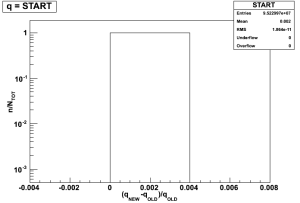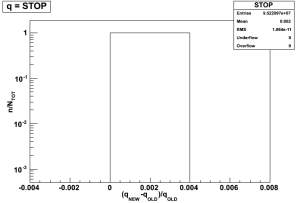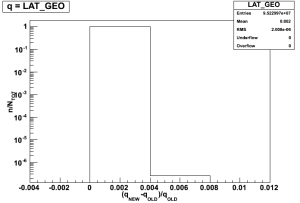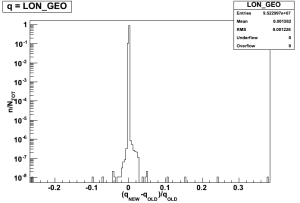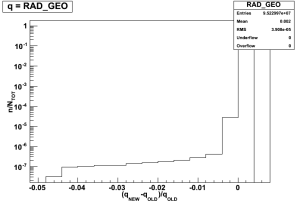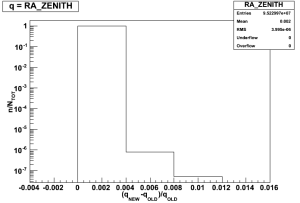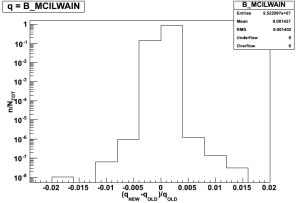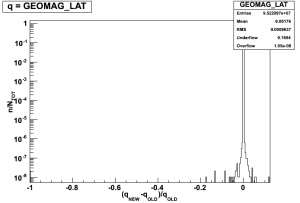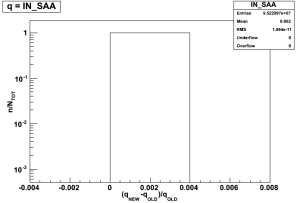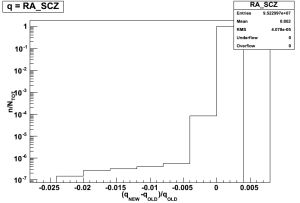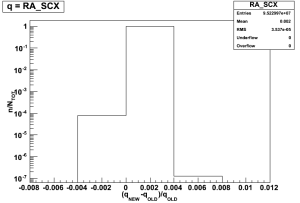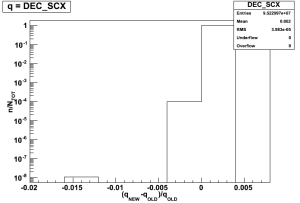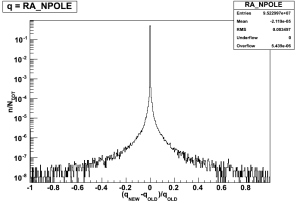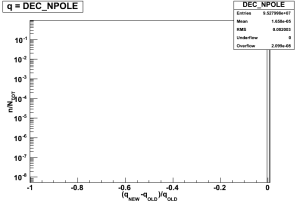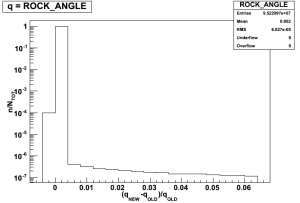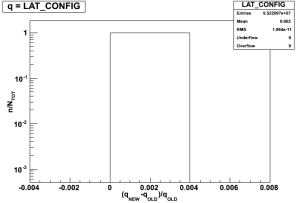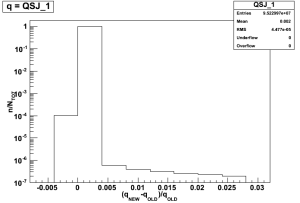Reprocessing P130 used the new ft2Util code to produce FT2 files.
Here I present the comparison between the files produced during P130 and the old files, archived in the astro server and produced with the old code. All plots refers to 1s FT2 files, unless otherwise stated.
For each quantity q in the FT2 file I report a histogram of the fractional difference between the "new" FT2 file (from P130) and the "old" one (from the archive): (qNEW-qOLD)/qOLD.
There are two main reasons for the small differences observed in the comparison:
- The new code does a better job at the margin of the runs: the spacecraft position and attitude (and related quantities) are computed starting from messages in the Magic 7 file. The new code uses the whole M7 file, which usually cover a broader time interval than the run, to compute position and attitude at the start time and end time of the run. The old code, instead, discarded all the messages before the start and after the stop of the run, computing position and attitude at those instants by extrapolation.
- A bug in the old code (see below for explanations)
Quantity |
Columns in the FT2 file |
Histograms |
Comment |
|---|---|---|---|
Bin start and stop |
START, STOP |
|
No differences. Actually, there will be differences, because of a different strategy of handling gaps between the new and the old code described in the "mother page". But for this comparison I have chosen only bins in common between the version from the reprocessing and the archived version. |
Spacecraft position in ECI coordiantes (x,y,z) |
SC_POSITION array |
|
The differences in a very small number of bins are most probably due to Reason 1 above. |
Ground point latitude and longitude |
LAT_GEO, LON_GEO |
|
Reason 1. |
Spacecraft altitude |
RAD_GEO |
|
Reason 1. |
Zenith direction |
RA_ZENITH, DEC_ZENITH |
|
|
McIlwain coordinates |
L_MCILWAIN, B_MCILWAIN |
|
|
Geomagnetic latitude |
GEOMAG_LAT |
|
16 percent of the time bins are in the underflow bin of the histogram. This is due to a known issue: on Feb. 2, 2010 we changed the quantity from unsigned to signed. Thus, all old FT2 files produced before that date have a always-positive GEOMAG_LAT, while the reprocessed ones have it signed from the beginning of the mission. |
South Atlantic Anomaly flag |
IN_SAA |
|
|
Z-axis direction |
RA_SCZ, DEC_SCZ |
|
Reason 1. |
X-axis direction |
RA_SCX, DEC_SCX |
|
Reason 1. |
Orbital Pole direction |
RA_NPOLE, DEC_NPOLE |
|
Here there are considerable differences, because the new code compute the coordinates of the Orbital Pole in a different way respect to the old one. If vi is the position vector for the i-th bin in the FT2 file, the old code computed the orbital pole vector for the i-th bin as the cross product between vi-1 and vi, while the new code uses the product vi cross vi+1. See next section for more information. |
Rocking angle |
ROCK_ANGLE |
|
Reason 1. |
LAT GNC mode |
LAT_MODE |
|
|
LAT Configuration |
LAT_CONFIG |
|
|
Data quality flag |
DATA_QUAL |
|
Need to check why there are these differences in a couple of runs. I suspect those are BAD runs, or runs with the new values for the DQM flag. |
Attitude quaternion |
QSJ_1,QSJ_2,QSJ_3,QSJ_4 |
|
Reason 1. |
Live time |
LIVETIME |
|
Differences are due to the bug already found in the old FT2 code. See below. |
Livetime
As already found in my former test (see the mother page), the old code had a bug in the livetime computation. Here I show the difference in livetime between the two codes, as function of time:
| There are no images attached to this page. |
